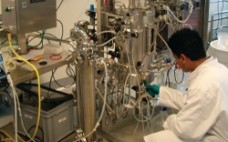Metabolic process engineering (MPE) was developed at Bristol-Myers Squibb Company as a tool to effectively control and optimize industrial cell culture processes used for production of biological drugs. A fundamental need was identified to introduce manipulations to the metabolism of production cell lines without genetic engineering. Optimization goals for production cell line performance include, for example, volumetric productivity, control of product quality attributes and by-product formation, and improved process scalability. With MPE, we could achieve targeted changes to cellular metabolism…
Upstream Processing
Noninvasive Optical Sensor Technology in Shake Flasks
In process development, appropriate scaling is important to achieve acceptable product quality without compromising titer (1). Scale-down approaches involve matching the oxygen transfer coefficient (kLa) value, impeller tip speed, power per unit volume, or mixing time to those of a bioreactor (2). Bench-top bioreactors are typically used in bioprocess engineering as scale-down models of commercial units in fermentation and cell culture because of their similarity in geometry (H/D ratio) and mechanical properties (agitation type and sparging). By contrast, shaking culture…
Rapid Production of Functional Proteins of a Combinatorial IgG Library in CHO Cells
Recombinant DNA (rDNA) technologies provide a wide range of tools for producing a broad array of recombinant proteins. Since the early 1970s, the biotechnology industry has harnessed those tools — together with genetic engineering and genomics — for developing new classes of innovative and effective therapeutic molecules. The therapeutic recombinant protein market segment now represents the core of the medical biotechnology industry, with hundreds of companies involved in discovery, development, and marketing. Although recombinant technologies are extremely powerful tools, significant…
Differential Cell Culture Media for Single-Cell Cloning
Recombinant therapeutic protein production using cell culture systems is a US$70 billion market. Most biotherapeutic proteins, including monoclonal antibodies (MAbs), are produced in Chinese hamster ovary (CHO) cells, which can generate the posttranslational modifications required for full biological function. Single-cell cloning is an important step in generating homogenous recombinant protein-producing mammalian cell lines. Recent advances in media development technologies have enabled limiting dilution cloning (LDC) and protein production in a serum-free environment to meet regulatory requirements. LDC…
Performing Quality by Design on hydrolysates: a DOE case study
Hydrolysates provide increased cell growth and titers. The aim of FrieslandCampina Domo is to re-define hydrolysates and re-design their quality profile. The Quality by Design concept as put forward by the FDA proves to be an excellent framework for achieving these goals. In addition it will also enable FrieslandCampina Domo to provide a Design Space of this critical raw material for the biopharmaceutical industry and so making process changes easier and cost effective. FrieslandCampina Domo has analysed protein hydrolysates at…
Trends in Perfusion Bioreactors
Single-use bioprocessing equipment has come to thoroughly dominate precommercial biopharmaceutical production in only a decade. Yet even with this breakthrough, performance and cost pressures on biopharmaceutical facilities continue to grow. Demands for greater productivity, more efficiency, and lower costs are resulting in an unrelenting push for upstream improvements. Some people in the industry are predicting that perfusion bioreactor technologies may be the next revolution in bioprocessing (1). Perfusion may possibly become a dominant single-use bioreactor technology, with fed-batch…
A Brief History of Perfusion Biomanufacturing
Today’s renewed interest in perfusion culture is due to an increased awareness of its advantages, some general improvement in equipment reliability, and a broadening of operational skills in the biomanufacturing industry. Some misperceptions persist, however, according to a 2011 review by Eric Langer (1). Our view here of the history of perfusion and fed-batch processes includes some discussion of technological process improvements and challenges that the bioprocess industry faces. A team of authors at Serono in Switzerland wrote…
Intensified Manufacturing: Economic Models Comparing Steel, Single-Use and Concentrated Process Options
Refine Technology, LLC, in conjunction with Biopharm Services, developed two economic models to examine the cost of goods and capital requirements of cell culture production facilities configured based on different production scenarios, including variables such as:
• Amount of product required
• Vessel sizes
• Number and type of vessels (stainless steel vs. single use)
• Product titer
• Seed train
• Upstream and downstream requirements
In this educational webcast, John Bonham-Carter, Vice President of Sales and Business Development at Refine Technology, analyzes the effect of these variables in relation to operating mode, continuous culture (perfusion) versus traditional fed batch. Join John as he presents results and discussion for facilities producing 50 and 500Kg of protein per year.
Trends and New Technology in Vaccine Manufacturing
Significant changes are sweeping the vaccine manufacturing industry. Demand for human vaccines is predicted to grow significantly — in part driven by needs in emerging countries, where only small fractions of their large and growing populations has access to vaccines. Sustained growth is expected to yield a vaccine market of US$25 billion by the year 2015 (1). Relatively low immunization rates in the Asia–Pacific regions represent significant untapped potential for vaccine manufacturers. Growing populations, increased government funding, and increasing personal…
Pseudomonas fluorescens Expression Technology for Subunit Vaccine Production and Development
New methods and platforms for rapid development and production of effective subunit vaccines have become a 21st-century imperative. Not only is it important to rapidly express and produce a large number of antigens, but those antigens must be expressed and folded such that their effectiveness in preclinical studies is predictive of their potential effectiveness as vaccines. This task has created a bottleneck in vaccine development because recombinant protein expression is difficult and time-consuming, involving a large number of variables. Highly…


